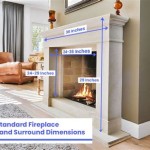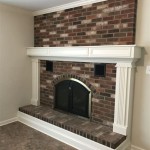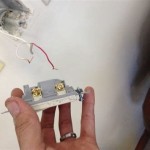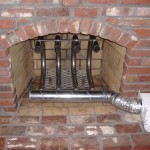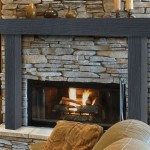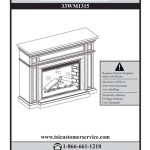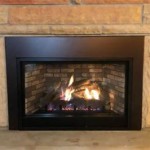Fireplace Heater Insert Blower: Enhancing Heating Efficiency and Comfort
A fireplace heater insert blower is a critical component designed to significantly improve the heating efficiency of a fireplace insert. Fireplace inserts, unlike traditional open fireplaces, are closed combustion systems that are inserted into existing fireplaces. While inserts themselves increase heating efficiency compared to open fireplaces, a blower can dramatically enhance their performance, distributing heat more effectively throughout a room or entire home. The blower works by circulating air around the firebox of the insert, drawing cool air from the room, heating it, and then forcing the warm air back into the living space. This forced-air convection system is far more effective than the radiant heat produced by the insert alone.
The integration of a fireplace heater insert blower offers several advantages, ranging from improved heating consistency to reduced energy consumption. Understanding the functionality, types, benefits, and considerations when choosing a blower is essential for maximizing the performance and efficiency of a fireplace insert. This article will provide a comprehensive overview of fireplace heater insert blowers, outlining key aspects for homeowners considering this upgrade.
Understanding the Functionality of a Fireplace Insert Blower
The core function of a fireplace insert blower is to facilitate convection heating. Without a blower, the heat produced by a fireplace insert primarily radiates outwards. This radiant heat is most intense near the insert and diminishes rapidly with distance, resulting in uneven heating within the room. The air closest to the insert becomes significantly warmer while other areas remain relatively cool. This localized heating can be inefficient and uncomfortable, especially in larger rooms or open-concept living spaces.
A blower mitigates this issue by drawing cool air from the room, usually near the floor, across the heated surfaces of the firebox (the metal enclosure containing the fire). As the air passes over these heated surfaces, it absorbs heat through conduction. The warmed air is then forced out of the insert through vents, typically located at the top or front of the unit. This forced air circulation creates a convection current, distributing the heat more evenly throughout the room and helping to warm adjacent areas. This process warms the space more rapidly and maintains a more consistent temperature.
The blower's efficiency depends on several factors, including its airflow capacity (measured in cubic feet per minute or CFM), the design of the fireplace insert, and the size and layout of the room. A higher CFM rating indicates that the blower can move a larger volume of air, potentially improving heat distribution in larger spaces. However, the design of the insert's heat exchanger and the placement of the vents also play a crucial role in how effectively the blower distributes the heated air. Obstacles in the room, such as furniture or partitions, can also affect airflow and reduce the blower's effectiveness.
Typically, fireplace insert blowers are electrically powered, requiring a standard household electrical outlet. They often feature variable speed controls, allowing users to adjust the airflow and heat output to suit their comfort preferences and heating needs. Some models also incorporate thermal sensors that automatically activate the blower when the firebox reaches a certain temperature, and deactivate it when the fire cools down. This automatic operation enhances convenience and prevents the blower from running unnecessarily when the insert is not actively producing heat.
Types of Fireplace Insert Blowers
Fireplace insert blowers can be broadly categorized based on their design and installation method. Understanding these different types allows homeowners to select the most suitable blower for their specific fireplace insert and heating requirements.
Built-in Blowers: These blowers are designed to be integrated directly into the fireplace insert during manufacturing. They are specifically tailored to the insert's dimensions and airflow requirements, ensuring optimal performance and a seamless appearance. Built-in blowers are generally the most efficient and reliable option, as they are engineered to work in conjunction with the insert's heating system. They typically feature quiet operation and variable speed controls, providing precise control over heat output. However, built-in blowers can be more expensive than aftermarket options and may require professional installation if not already included with the insert.
Aftermarket Blowers: These blowers are designed to be installed in existing fireplace inserts that did not originally come equipped with a blower. They are available in a variety of sizes and configurations to fit different insert models. Aftermarket blowers offer a cost-effective way to enhance the heating performance of an older or less expensive fireplace insert. However, it's crucial to select an aftermarket blower that is compatible with the specific insert model to ensure proper fit and airflow. Incorrectly sized or incompatible blowers can reduce heating efficiency, cause noise issues, or even damage the insert. Installation of an aftermarket blower may require some technical skill and may involve removing the insert from the fireplace opening.
Universal Blowers: Similar to aftermarket blowers, universal blowers are designed to fit a wide range of fireplace insert models. They typically come with adjustable mounting brackets and various adapters to accommodate different insert sizes and vent configurations. While universal blowers offer a convenient and flexible solution, their performance may not be as optimized as that of built-in or model-specific aftermarket blowers. It's essential to carefully measure the insert's dimensions and airflow requirements before purchasing a universal blower to ensure a proper fit and adequate performance. Like aftermarket blowers, installation may require some technical skills and may necessitate removing the insert.
When choosing a fireplace insert blower, it's important to consider the following factors: the blower's CFM rating, the insert's dimensions and vent locations, the blower's noise level (measured in decibels or dB), and the blower's power consumption (measured in watts). A higher CFM rating may be necessary for larger rooms, while a lower noise level is desirable for quieter operation. Power consumption can impact energy costs, so it's prudent to choose a blower with reasonable energy efficiency. Consulting the fireplace insert manufacturer's specifications or seeking advice from a qualified HVAC technician can help homeowners select the most appropriate blower for their needs.
Benefits of Using a Fireplace Insert Blower
Implementing a fireplace insert blower offers a multitude of benefits that improve the overall heating efficiency and comfort provided by the fireplace insert. These advantages extend beyond simple heat distribution and contribute to reduced energy costs and increased homeowner satisfaction.
Enhanced Heating Efficiency: The primary benefit of a fireplace insert blower is significantly improved heating efficiency. By facilitating convection heating, the blower distributes warm air more evenly throughout the room, eliminating cold spots and maintaining a consistent temperature. This increased efficiency reduces the amount of fuel needed to heat the space, translating to lower heating costs. The blower ensures that the heat generated by the fire is utilized effectively, rather than being lost to the chimney or concentrated in a small area near the insert.
Improved Comfort: The even heat distribution provided by a blower creates a more comfortable living environment. Without a blower, radiant heat from the insert can feel intense and uncomfortable for those sitting nearby, while other areas of the room remain cool. A blower eliminates this temperature disparity, creating a more pleasant and inviting atmosphere. This uniform heating is especially beneficial in rooms with high ceilings or open floor plans, where radiant heat alone may not be sufficient to effectively warm the entire space.
Faster Heating: A fireplace insert blower can significantly reduce the time it takes to heat a room. By actively circulating air around the firebox, the blower quickly extracts heat and distributes it throughout the space. This rapid heating is particularly advantageous in colder climates or when returning home to a cold house. The blower allows the fireplace insert to quickly reach its optimal operating temperature, providing immediate warmth and comfort.
Reduced Energy Consumption: While the blower itself consumes a small amount of electricity, the overall energy consumption can be reduced by enhancing the heating efficiency of the fireplace insert. With more efficient heat distribution, the insert needs to burn less fuel to maintain a comfortable temperature. This reduction in fuel consumption translates to lower energy bills and a smaller carbon footprint. The blower allows homeowners to get the most out of their fireplace insert, minimizing waste and maximizing energy savings.
Extended Lifespan of the Fireplace Insert: By promoting even heat distribution, a blower can potentially extend the lifespan of the fireplace insert. Localized overheating can stress the insert's components, leading to premature wear and tear. A blower helps to dissipate heat evenly, reducing the risk of overheating and prolonging the insert's operational life. This extends the investment in the fireplace insert, reducing the need for repairs or replacement.
In conclusion, a fireplace heater insert blower is a valuable addition for homeowners seeking to maximize the heating performance and efficiency of their fireplace insert. By understanding the functionality, types, and benefits of blowers, homeowners can make informed decisions and enjoy a more comfortable and energy-efficient heating experience.

Ventis Hei240 Fireplace Insert With Blower

Wood Fireplace Inserts With Blowers Upgrade Your

Ventis Hei240 Fireplace Insert With Blower

Fireplace Blowers Explained How Fans Work Regency

Osburn 3500 Wood Stove With Blower

Ventis Wood Burning Fireplace Insert With Blower Hei170 Hvacdirect Com

Osburn Matrix Wood Burning Insert Woodland Direct

Osburn 3300 Freestanding Wood Stove Fireplace With Blower Fireplaces By Cameron

Buck Stove Model 91 Insert Fireplace Buy Hearth Patio

Ventis Hei240 Fireplace Insert With Blower
Related Posts

